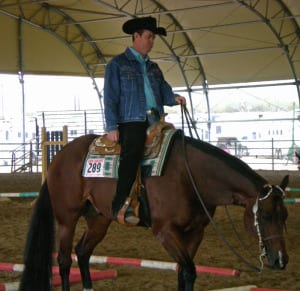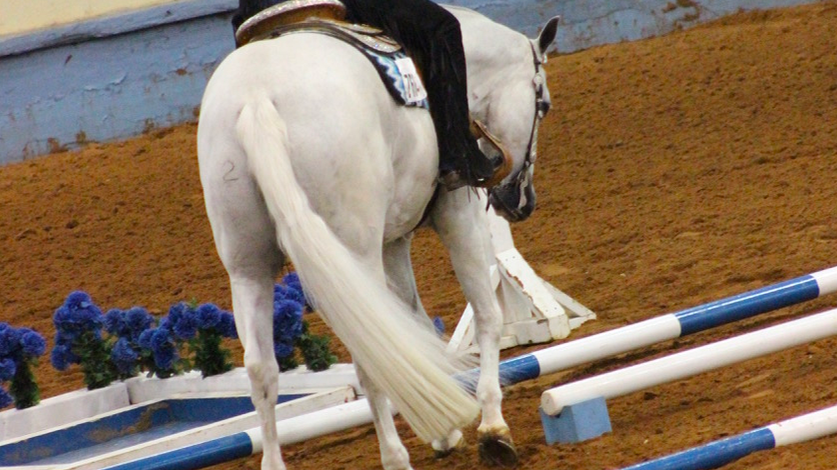Much emphasis is placed on working on and perfecting the “complicated moves” in a pattern: the lead change, the lope/trot over logs, or the patterns with tons of speed changes. However, the skills that earn the most plusses or minuses on a judge’s card are often thought to be more “basic” in nature.
We spoke with the experts to get their take on perfecting the fundamental movements that are frequently overlooked in a pattern. In this three-part series, we get advice from Leonard Berryhill, John Briggs, and Sara Simons on making the (1) stop, (2) back, and (3) side pass consistent point-earning opportunities.
Our experts discussed the stop in part 1, the back in part 2, and today’s focus is the side pass. Whether side passing over a pole, to a gate, or at a cone, an accurate and smooth side pass is a significant point-scoring opportunity.

Leonard Berryhill (The Scoring Approach):
Berryhill is a fan of the side pass and is happy to see it return more frequently in patterns at the top levels of horse showing. He says it used to be a common element to a pattern, and then there was a period where it was very underutilized. However, the side pass has been “making a comeback” in patterns over the past five years, and, therefore, riders must practice performing it correctly.
Berryhill believes that, between the stop, back, and side pass, the side pass presents one of the more significant opportunities to earn points in a pattern. But, with an excellent opportunity to earn credit comes an equally great chance to lose it.
When scoring a side pass, Berryhill looks for the horse that needs to move off the rider’s leg willingly and continue moving off the leg in a straight, horizontal manner. But, again, Berryhill likes to see the communication between the horse and rider, and he has no problem with the rider lifting their hand softly and guiding the horse through it.
Berryhill looks for the horse to maintain its frame throughout the entire side pass and be soft and willing, mainly through its neck and face. He doesn’t want to see them opening their mouth, lifting their neck, or bending their neck through the side pass.
Ideally, Berryhill wants to see the horse’s front and back legs cross over simultaneously – meaning that the front and back legs will cross in front of the planting leg at the same time, instead of the front then back or vice versa. “When a horse crosses over simultaneously and smoothly, they impress me, and I will always give them big plusses for that.”
According to Berryhill, “If you see the legs crossing, but not in unison, it can still earn some credits, so long as the horse maintains its frame and cadence.” That said, he does not want to see a horse moves back and forth, which will result in the horse not moving horizontally through the side pass. He also doesn’t want the horse to cross under – meaning crossing behind the planting leg instead of in front of it.
Aside from not moving horizontally, the biggest mistake is where the horse will shuffle the step. This is where they step to the planting foot and don’t cross legs. He says a horse that doesn’t move horizontally, shuffles through the maneuver, or constantly needs to stop and readjust will lose a lot of points on the side pass.

John Briggs (The Foundational Approach):
Briggs believes that a correct, evenly horizontal side pass must be taught properly. In addition, he strongly recommends using tools to help the animal become an active participant in their training at the side pass. Briggs has found that, “A horse that is mentally engaged in the process and has to think through what they are doing is more likely to retain the lesson.”
Briggs recommends using railroad ties to assist in establishing a proper side pass. He will set them up in front of and behind the horse so that they don’t move forward or backward when he applies pressure on their side to move them over. He likes using the larger railroad ties instead of trail poles because the horse cannot move them out of the way, and they learn to be more respectful of the boundary.
Briggs says that your hand should be in charge of the shoulders, and your leg should be in charge of the ribcage and hindquarters when teaching the side pass. He says you must prepare the horse from the beginning that they cannot side pass by leading with their shoulders or hindquarters – an accurate side pass must come from the rib cage over.
Briggs says this maneuver requires lots of time and practice to perfect. “Put your time in on the side pass. Make sure you put your horse in the right position to side pass successfully because this is one maneuver that, once it goes south, it’s hard to get it back.”
Briggs’ pro tip is that, “If I’m side passing a single-pole, I always try to line [the pole] up with the back cinch ring on the saddle. This will establish a pretty good mid-point on your horse’s body to make sure you’ve put them in a position to succeed from the set up.”

Sara Simons (The Body Control Approach):
According to Simons, “A quality side pass will have the horse moving horizontally, crossing with the front and hind legs at the same time.” But, again, she emphasizes that if the horse’s body can move independently, you can make the parts move together in one fluid motion.
Like Briggs, Simons recommends introducing the side pass to the horse using a tool. She has found that young horses tend to want to cheat by moving forward when asking them to side pass, so it helps to put a solid barrier in front of their face in the beginning, she will typically use a wall or fence as a tool to have the horse stand perpendicular to the barrier and then ask them to move horizontally along it in both directions.
She says broke horses are excellent aids to helping their riders learn the proper leg positioning for a side pass because they will “tell on their rider.” In other words, the horse will move the front end if the riders leg is too forward and, conversely, the horse will want to lead with its hind if the pressure is too far back. Therefore, she advises riders learning how to cue a side pass work with a broke horse that responds well to pressure to teach them how to ask correctly.
Like any maneuver, Simons says the key to success is twofold: (1) repetition and (2) proper cueing. She advises riders to take their time on the slow maneuvers in a pattern. It can be common to want to speed through the side pass to get it over with. However, it is more likely the horse will not move even if you are rushing through the maneuver.
***
The goal of any pattern element is to complete it correctly with light contact. And, all of our experts agree, the best way to ensure both of these goals are met is by consistent, correct practice at home and at shows.
In case you missed them, be sure to check out Part 1 – The Stop and Part 2 – The Back.








